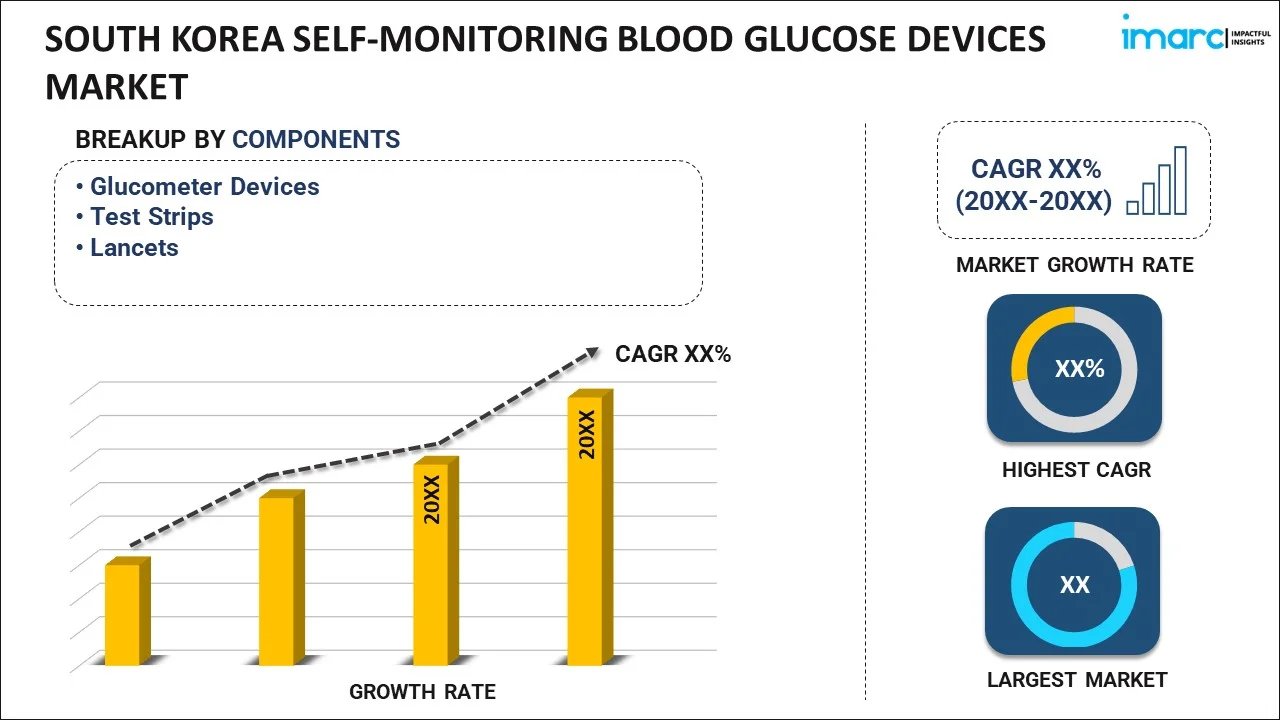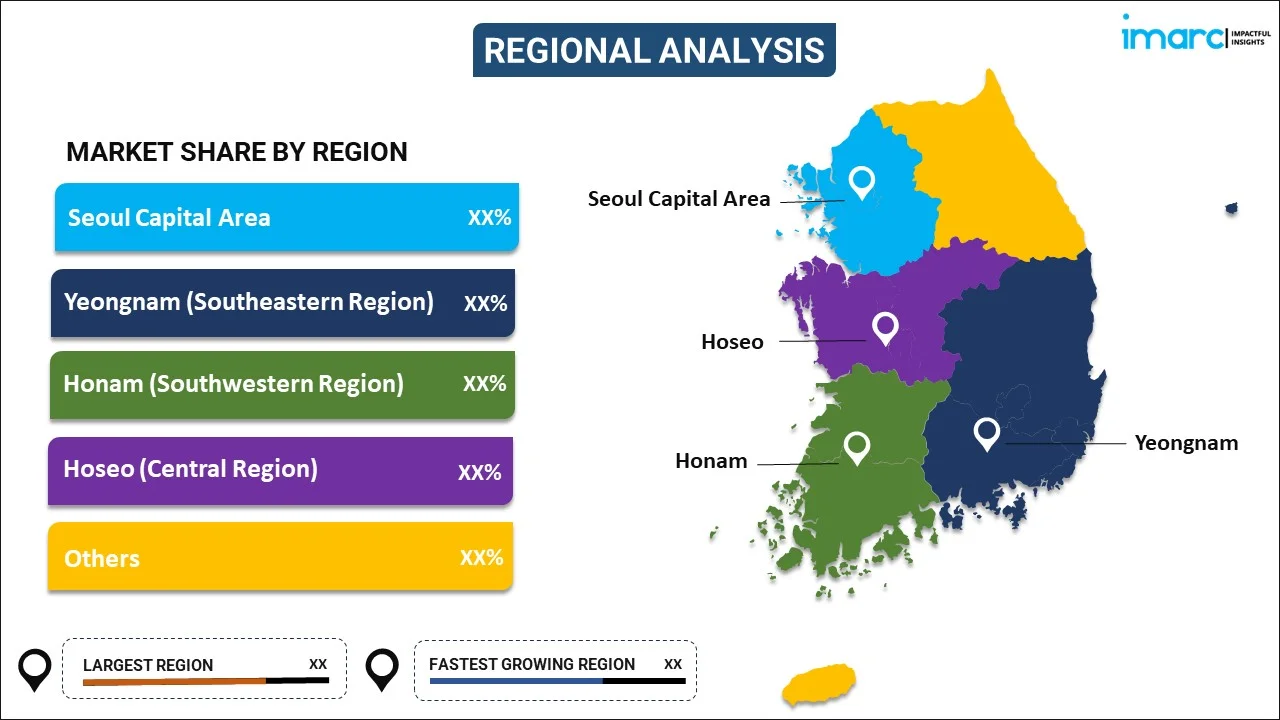
South Korea Self-Monitoring Blood Glucose Devices Market Report by Component (Glucometer Devices, Test Strips, Lancets), and Region 2024-2032
Market Overview:
South Korea self-monitoring blood glucose devices market size is projected to exhibit a growth rate (CAGR) of 2.20% during 2024-2032. The rising diabetes prevalence, growing awareness about the importance of early detection and effective management of diabetes, significant advancements in technology, the adoption of telehealth and remote monitoring, favorable government initiatives, rapidly aging population represent some of the key factors driving the market.
|
Report Attribute
|
Key Statistics
|
|---|---|
|
Base Year
|
2023 |
|
Forecast Years
|
2024-2032
|
|
Historical Years
|
2018-2023
|
| Market Growth Rate (2024-2032) | 2.20% |
Self-monitoring blood glucose devices, commonly known as glucometers, are essential tools for individuals with diabetes to manage their condition effectively. These devices enable users to measure their blood glucose levels conveniently and regularly, providing crucial insights into their diabetes management. A typical self-monitoring blood glucose device consists of a small handheld meter and disposable test strips. To use it, a person with diabetes pricks their finger to obtain a tiny drop of blood, which is then placed on the test strip. The meter then analyzes the blood sample and displays the current blood glucose level within seconds. These devices have become increasingly user-friendly, with many featuring easy-to-read screens and audio prompts, making them accessible to a wide range of users.
South Korea Self-Monitoring Blood Glucose Devices Market Trends:
South Korea has witnessed a steady increase in diabetes prevalence over the years. This rise in the number of individuals living with diabetes has created a substantial demand for self-monitoring blood glucose devices as essential tools for daily management. Additionally, there is an increasing awareness about the importance of early detection and effective management of diabetes among South Koreans. This heightened awareness has prompted more individuals to monitor their blood glucose levels regularly, accelerating the sales of monitoring devices. Other than this, the South Korean market benefits from continuous advancements in self-monitoring blood glucose device technology. These innovations include devices that are more accurate, user-friendly, and capable of seamless data integration with smartphones and other digital health platforms. Besides this, the COVID-19 pandemic accelerated the adoption of telehealth and remote monitoring solutions in South Korea. Self-monitoring blood glucose devices play a crucial role in remote patient monitoring programs, allowing healthcare providers to track patients' glucose levels remotely and provide timely interventions. In line with this, patients in South Korea are becoming more proactive in managing their health. Self-monitoring blood glucose devices empower individuals with diabetes to take control of their condition, resulting in improved self-care and overall well-being. Furthermore, a competitive market with multiple manufacturers and suppliers of self-monitoring blood glucose devices has led to product diversity, price competitiveness, and ongoing innovation. Moreover, the aging population is more susceptible to diabetes, leading to an increased demand for self-monitoring blood glucose devices across the country. The Government of South Korea has taken proactive steps to address the rising prevalence of diabetes. Various healthcare policies and initiatives aimed at diabetes management and prevention have been implemented. These initiatives often involve subsidies or reimbursement programs that encourage individuals to invest in self-monitoring blood glucose devices, further boosting market demand.
South Korea Self-Monitoring Blood Glucose Devices Market Segmentation:
IMARC Group provides an analysis of the key trends in each segment of the market, along with forecasts at the country level for 2024-2032. Our report has categorized the market based on component.
Component Insights:

- Glucometer Devices
- Test Strips
- Lancets
The report has provided a detailed breakup and analysis of the market based on the component. This includes glucometer devices, test strips, and lancets.
Regional Insights:

- Seoul Capital Area
- Yeongnam (Southeastern Region)
- Honam (Southwestern Region)
- Hoseo (Central Region)
- Others
The report has also provided a comprehensive analysis of all the major regional markets, which include Seoul Capital Area, Yeongnam (Southeastern Region), Honam (Southwestern Region), Hoseo (Central Region), and others.
Competitive Landscape:
The market research report has also provided a comprehensive analysis of the competitive landscape in the market. Competitive analysis such as market structure, key player positioning, top winning strategies, competitive dashboard, and company evaluation quadrant has been covered in the report. Also, detailed profiles of all major companies have been provided. Some of the key players include:
- Arkray Inc.
- Abbott Korea Co. Ltd.
- i-Sens Inc.
(Please note that this is only a partial list of the key players, and the complete list is provided in the report.)
South Korea Self-Monitoring Blood Glucose Devices Market Report Coverage:
| Report Features | Details |
|---|---|
| Base Year of the Analysis | 2023 |
| Historical Period | 2018-2023 |
| Forecast Period | 2024-2032 |
| Units | US$ Million |
| Scope of the Report | Exploration of Historical and Forecast Trends, Industry Catalysts and Challenges, Segment-Wise Historical and Predictive Market Assessment:
|
| Components Covered | Glucometer Devices, Test Strips, Lancets |
| Regions Covered | Seoul Capital Area, Yeongnam (Southeastern Region), Honam (Southwestern Region), Hoseo (Central Region), Others |
| Companies Covered | Arkray Inc., Abbott Korea Co. Ltd., i-Sens Inc., etc. (Please note that this is only a partial list of the key players, and the complete list is provided in the report.) |
| Customization Scope | 10% Free Customization |
| Report Price and Purchase Option | Single User License: US$ 3699 Five User License: US$ 4699 Corporate License: US$ 5699 |
| Post-Sale Analyst Support | 10-12 Weeks |
| Delivery Format | PDF and Excel through Email (We can also provide the editable version of the report in PPT/Word format on special request) |
Key Questions Answered in This Report:
- How has the South Korea self-monitoring blood glucose devices market performed so far and how will it perform in the coming years?
- What has been the impact of COVID-19 on the South Korea self-monitoring blood glucose devices market?
- What is the breakup of the South Korea self-monitoring blood glucose devices market on the basis of component?
- What are the various stages in the value chain of the South Korea self-monitoring blood glucose devices market?
- What are the key driving factors and challenges in the South Korea self-monitoring blood glucose devices?
- What is the structure of the South Korea self-monitoring blood glucose devices market and who are the key players?
- What is the degree of competition in the South Korea self-monitoring blood glucose devices market?
Key Benefits for Stakeholders:
- IMARC’s industry report offers a comprehensive quantitative analysis of various market segments, historical and current market trends, market forecasts, and dynamics of the South Korea self-monitoring blood glucose devices market from 2018-2032.
- The research report provides the latest information on the market drivers, challenges, and opportunities in the South Korea self-monitoring blood glucose devices market.
- Porter's five forces analysis assist stakeholders in assessing the impact of new entrants, competitive rivalry, supplier power, buyer power, and the threat of substitution. It helps stakeholders to analyze the level of competition within the South Korea self-monitoring blood glucose devices industry and its attractiveness.
- Competitive landscape allows stakeholders to understand their competitive environment and provides an insight into the current positions of key players in the market.
Need more help?
- Speak to our experienced analysts for insights on the current market scenarios.
- Include additional segments and countries to customize the report as per your requirement.
- Gain an unparalleled competitive advantage in your domain by understanding how to utilize the report and positively impacting your operations and revenue.
- For further assistance, please connect with our analysts.
 Inquire Before Buying
Inquire Before Buying
 Speak to an Analyst
Speak to an Analyst
 Request Brochure
Request Brochure
 Request Customization
Request Customization




.webp)




.webp)












